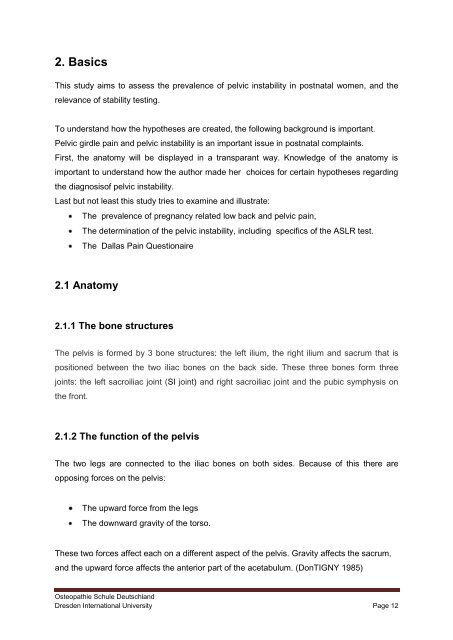Pelvic girdle pain and relevance of ASLR testing: A ... - Cindy Verheul
Pelvic girdle pain and relevance of ASLR testing: A ... - Cindy Verheul
Pelvic girdle pain and relevance of ASLR testing: A ... - Cindy Verheul
Create successful ePaper yourself
Turn your PDF publications into a flip-book with our unique Google optimized e-Paper software.
2. Basics<br />
This study aims to assess the prevalence <strong>of</strong> pelvic instability in postnatal women, <strong>and</strong> the<br />
<strong>relevance</strong> <strong>of</strong> stability <strong>testing</strong>.<br />
To underst<strong>and</strong> how the hypotheses are created, the following background is important.<br />
<strong>Pelvic</strong> <strong>girdle</strong> <strong>pain</strong> <strong>and</strong> pelvic instability is an important issue in postnatal complaints.<br />
First, the anatomy will be displayed in a transparant way. Knowledge <strong>of</strong> the anatomy is<br />
important to underst<strong>and</strong> how the author made her choices for certain hypotheses regarding<br />
the diagnosis<strong>of</strong> pelvic instability.<br />
Last but not least this study tries to examine <strong>and</strong> illustrate:<br />
The prevalence <strong>of</strong> pregnancy related low back <strong>and</strong> pelvic <strong>pain</strong>,<br />
The determination <strong>of</strong> the pelvic instability, including specifics <strong>of</strong> the <strong>ASLR</strong> test.<br />
The Dallas Pain Questionaire<br />
2.1 Anatomy<br />
2.1.1 The bone structures<br />
The pelvis is formed by 3 bone structures: the left ilium, the right ilium <strong>and</strong> sacrum that is<br />
positioned between the two iliac bones on the back side. These three bones form three<br />
joints: the left sacroiliac joint (SI joint) <strong>and</strong> right sacroiliac joint <strong>and</strong> the pubic symphysis on<br />
the front.<br />
2.1.2 The function <strong>of</strong> the pelvis<br />
The two legs are connected to the iliac bones on both sides. Because <strong>of</strong> this there are<br />
opposing forces on the pelvis:<br />
The upward force from the legs<br />
The downward gravity <strong>of</strong> the torso.<br />
These two forces affect each on a different aspect <strong>of</strong> the pelvis. Gravity affects the sacrum,<br />
<strong>and</strong> the upward force affects the anterior part <strong>of</strong> the acetabulum. (DonTIGNY 1985)<br />
Osteopathie Schule Deutschl<strong>and</strong><br />
Dresden International University Page 12


